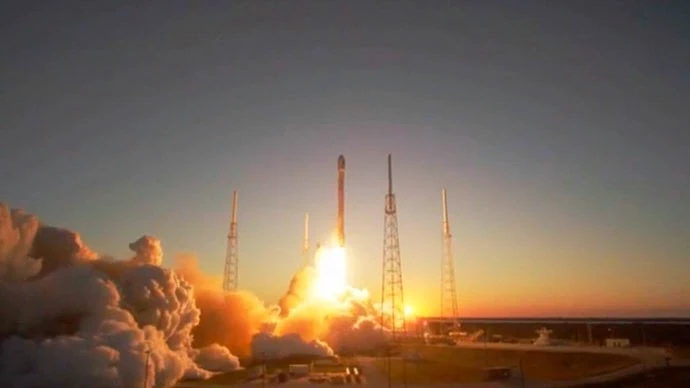A $340 million satellite that aims to alert people to potentially dangerous solar activity and geomagnetic storms blasted off toward deep space Wednesday atop a SpaceX Falcon 9 rocket...
Experts say the DSCOVR - a joint collaboration of the US Air Force, NASA and the National Oceanic and Atmospheric Administration (NOAA) - will help with the preparation and response to "space weather," thereby protecting utilities, consumers and industries.
"The Falcon takes flight, propelling the Deep Space Climate Observatory on a million mile journey to protect our planet Earth," said NASA commentator George Diller as the rocket took off from Cape Canaveral, Florida at 6:03 pm (2303 GMT).
DSCOVR is headed to a destination between the Earth and the sun known as Lagrangian point, or L1. The journey will take 110 days, followed by 40 days of instrument tests.
Space weather is the primary objective of the five-year mission, although the initial idea for the satellite came from former US vice president Al Gore, who dreamed of a spacecraft that would observe Earth and send back live images that would raise environmental awareness of the planet's fragility.
DSCOVR will replace an aging satellite, known as ACE, that is many years past its expiration date. It should provide the same accuracy as its predecessor, officials said.
Its secondary mission is to collect scientific data about aerosol levels, ozone and radiation balance on Earth.
Meanwhile, California-based SpaceX said high seas off the coast of Florida had forced it to abandon another planned attempt at recycling its rocket by flying the first stage of the Falcon 9 to a controlled landing on an ocean platform, known as a drone ship.
SpaceX is embarking on a series of such tests with the goal of one day making rockets as reusable as airplanes, instead of allowing them to fall to pieces into the ocean after launch.
An attempt to land the first stage on a floating barge in January was not successful. Instead of landing upright, the rocket collided with the platform and broke into pieces.
But the company said it intends to keep trying to refine the technology.
Source:AFP - globaltimes.cn
12/2/15
--
-
Related:
Related:
Experts say the DSCOVR - a joint collaboration of the US Air Force, NASA and the National Oceanic and Atmospheric Administration (NOAA) - will help with the preparation and response to "space weather," thereby protecting utilities, consumers and industries.
"The Falcon takes flight, propelling the Deep Space Climate Observatory on a million mile journey to protect our planet Earth," said NASA commentator George Diller as the rocket took off from Cape Canaveral, Florida at 6:03 pm (2303 GMT).
DSCOVR is headed to a destination between the Earth and the sun known as Lagrangian point, or L1. The journey will take 110 days, followed by 40 days of instrument tests.
Space weather is the primary objective of the five-year mission, although the initial idea for the satellite came from former US vice president Al Gore, who dreamed of a spacecraft that would observe Earth and send back live images that would raise environmental awareness of the planet's fragility.
DSCOVR will replace an aging satellite, known as ACE, that is many years past its expiration date. It should provide the same accuracy as its predecessor, officials said.
Its secondary mission is to collect scientific data about aerosol levels, ozone and radiation balance on Earth.
Meanwhile, California-based SpaceX said high seas off the coast of Florida had forced it to abandon another planned attempt at recycling its rocket by flying the first stage of the Falcon 9 to a controlled landing on an ocean platform, known as a drone ship.
SpaceX is embarking on a series of such tests with the goal of one day making rockets as reusable as airplanes, instead of allowing them to fall to pieces into the ocean after launch.
An attempt to land the first stage on a floating barge in January was not successful. Instead of landing upright, the rocket collided with the platform and broke into pieces.
But the company said it intends to keep trying to refine the technology.
Source:AFP - globaltimes.cn
12/2/15
--
-
Related:
Related:















 GR
GR FR
FR DE
DE ES
ES IT
IT RU
RU EU
EU